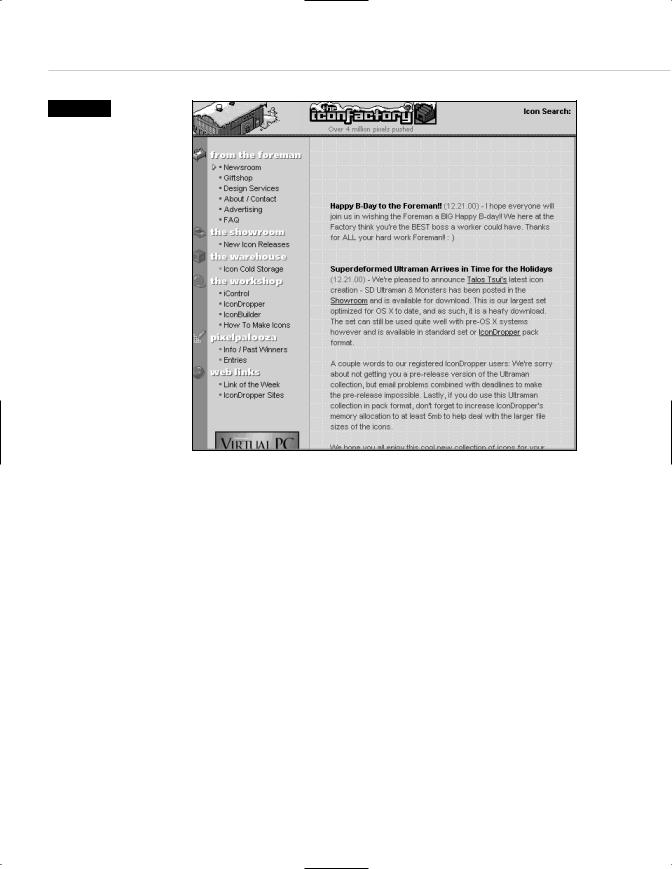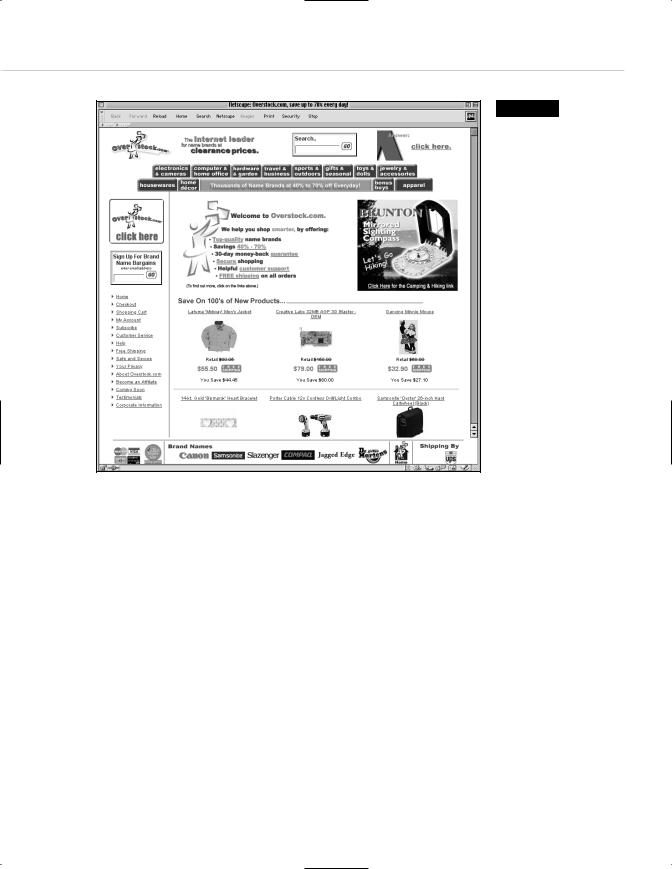
- •Taking Your Talent to the Web
- •Introduction
- •1 Splash Screen
- •Meet the Medium
- •Expanding Horizons
- •Working the Net…Without a Net
- •Smash Your Altars
- •Breath Mint? Or Candy Mint?
- •Where’s the Map?
- •Mars and Venus
- •Web Physics: Action and Interaction
- •Different Purposes, Different Methodologies
- •Web Agnosticism
- •Point #1: The Web Is Platform-Agnostic
- •Point #2: The Web Is Device-Independent
- •The 18-Month Pregnancy
- •Chocolatey Web Goodness
- •’Tis a Gift to Be Simple
- •Democracy, What a Concept
- •Instant Karma
- •The Whole World in Your Hands
- •Just Do It: The Web as Human Activity
- •The Viewer Rules
- •Multimedia: All Talking! All Dancing!
- •The Server Knows
- •It’s the Bandwidth, Stupid
- •Web Pages Have No Secrets
- •The Web Is for Everyone!
- •Swap text and code for images
- •Prune redundancy
- •Cache as Cache Can
- •Much Ado About 5K
- •Screening Room
- •Liquid Design
- •Color My Web
- •Thousands Weep
- •Gamma Gamma Hey!
- •Typography
- •The 97% Solution
- •Points of Distinction
- •Year 2000—Browsers to the Rescue
- •Touch Factor
- •Appropriate Graphic Design
- •User Knowledge
- •What Color Is Your Concept?
- •Business as (Cruel and) Usual
- •The Rise of the Interface Department
- •Form and Function
- •Copycats and Pseudo-Scientists
- •Chaos and Clarity
- •A Design Koan: Interfaces Are a Means too Often Mistaken for an End
- •Universal Body Copy and Other Fictions
- •Interface as Architecture
- •Ten (Okay, Three) Points of Light
- •Be Easily Learned
- •Remain Consistent
- •Continually Provide Feedback
- •GUI, GUI, Chewy, Chewy
- •It’s the Browser, Stupid
- •Clarity Begins at Home (Page)
- •I Think Icon, I Think Icon
- •Structural Labels: Folding the Director’s Chair
- •The Soul of Brevity
- •Hypertext or Hapless Text
- •Scrolling and Clicking Along
- •Stock Options (Providing Alternatives)
- •The So-Called Rule of Five
- •Highlights and Breadcrumbs
- •Consistent Placement
- •Brand That Sucker!
- •Why We Mentioned These Things
- •The year web standards broke, 1
- •The year web standards broke, 2
- •The year web standards broke, 3
- •The year the bubble burst
- •5 The Obligatory Glossary
- •Web Lingo
- •Extranet
- •HTML
- •Hypertext, hyperlinks, and links
- •Internet
- •Intranet
- •JavaScript, ECMAScript, CSS, XML, XHTML, DOM
- •Web page
- •Website
- •Additional terminology
- •Web developer/programmer
- •Project manager
- •Systems administrator (sysadmin) and network administrator (netadmin)
- •Web technician
- •Your Role in the Web
- •Look and feel
- •Business-to-business
- •Business-to-consumer
- •Solve Communication Problems
- •Brand identity
- •Restrictions of the Medium
- •Technology
- •Works with team members
- •Visually and emotionally engaging
- •Easy to navigate
- •Compatible with visitors’ needs
- •Accessible to a wide variety of web browsers and other devices
- •Can You Handle It?
- •What Is the Life Cycle?
- •Why Have a Method?
- •We Never Forget a Phase
- •Analysis (or “Talking to the Client”)
- •The early phase
- •Design
- •Brainstorm and problem solve
- •Translate needs into solutions
- •Sell ideas to the client
- •Identify color comps
- •Create color comps/proof of concept
- •Present color comps and proof of concept
- •Receive design approval
- •Development
- •Create all color comps
- •Communicate functionality
- •Work with templates
- •Design for easy maintenance
- •Testing
- •Deployment
- •The updating game
- •Create and provide documentation and style guides
- •Provide client training
- •Learn about your client’s methods
- •Work the Process
- •Code Wars
- •Table Talk
- •XHTML Marks the Spot
- •Minding Your <p>’s and q’s
- •Looking Ahead
- •Getting Started
- •View Source
- •A Netscape Bonus
- •The Mother of All View Source Tricks
- •Doin’ it in Netscape
- •Doin’ it in Internet Explorer
- •Absolutely Speaking, It’s All Relative
- •What Is Good Markup?
- •What Is Sensible Markup?
- •HTML as a Design Tool
- •The Frames of Hazard
- •Please Frame Safely
- •Framing Your Art
- •<META> <META> Hiney Ho!
- •Search Me
- •Take a (Re)Load Off
- •WYSIWYG, My Aunt Moira’s Left Foot
- •Code of Dishonor
- •WYS Is Not Necessarily WYG
- •Publish That Sucker!
- •HTMHell
- •9 Visual Tools
- •Photoshop Basics: An Overview
- •Comp Preparation
- •Dealing with Color Palettes
- •Exporting to Web-Friendly Formats
- •Gamma Compensation
- •Preparing Typography
- •Slicing and Dicing
- •Rollovers (Image Swapping)
- •GIF Animation
- •Create Seamless Background Patterns (Tiles)
- •Color My Web: Romancing the Cube
- •Dither Me This
- •Death of the Web-Safe Color Palette?
- •A Hex on Both Your Houses
- •Was Blind, but Now I See
- •From Theory to Practice
- •Format This: GIFs, JPEGs, and Such
- •Loves logos, typography, and long walks in the woods
- •GIFs in Photoshop
- •JPEG, the Other White Meat
- •Optimizing GIFs and JPEGs
- •Expanding on Compression
- •Make your JPEGS smaller
- •Combining sharp and blurry
- •Animated GIFs
- •Creating Animations in ImageReady
- •Typography
- •The ABCs of Web Type
- •Anti-Aliasing
- •Specifying Anti-Aliasing for Type
- •General tips
- •General Hints on Type
- •The Sans of Time
- •Space Patrol
- •Lest We Fail to Repeat Ourselves
- •Accessibility, Thy Name Is Text
- •Slicing and Dicing
- •Thinking Semantically
- •Tag Soup and Crackers
- •CSS to the Rescue…Sort of
- •Separation of Style from Content
- •CSS Advantages: Short Term
- •CSS Advantages: Long Term
- •Compatibility Problems: An Overview
- •Working with Style Sheets
- •Types of Style Sheets
- •External style sheets
- •Embedding a style sheet
- •Adding styles inline
- •Fear of Style Sheets: CSS and Layout
- •Fear of Style Sheets: CSS and Typography
- •Promise and performance
- •Font Size Challenges
- •Points of contention
- •Point of no return: browsers of the year 2000
- •Absolute size keywords
- •Relative keywords
- •Length units
- •Percentage units
- •Looking Forward
- •11 The Joy of JavaScript
- •What Is This Thing Called JavaScript?
- •The Web Before JavaScript
- •JavaScript, Yesterday and Today
- •Sounds Great, but I’m an Artist. Do I Really Have to Learn This Stuff?
- •Educating Rita About JavaScript
- •Don’t Panic!
- •JavaScript Basics for Web Designers
- •The Dreaded Text Rollover
- •The Event Handler Horizon
- •Status Quo
- •A Cautionary Note
- •Kids, Try This at Home
- •The Not-So-Fine Print
- •The Ever-Popular Image Rollover
- •A Rollover Script from Project Cool
- •Windows on the World
- •Get Your <HEAD> Together
- •Avoiding the Heartbreak of Linkitis
- •Browser Compensation
- •JavaScript to the Rescue!
- •Location, location, location
- •Watching the Detection
- •Going Global with JavaScript
- •Learning More
- •12 Beyond Text/Pictures
- •You Can Never Be Too Rich Media
- •Server-Side Stuff
- •Where were you in ‘82?
- •Indiana Jones and the template of doom
- •Serving the project
- •Doing More
- •Mini-Case Study: Waferbaby.com
- •Any Size Kid Can Play
- •Take a Walk on the Server Side
- •Are You Being Served?
- •Advantages of SSI
- •Disadvantages of SSI
- •Cookin’ with Java
- •Ghost in the Virtual Machine
- •Java Woes
- •Java Woes: The Politically Correct Version
- •Java Joys
- •Rich Media: Exploding the “Page”
- •Virtual Reality Modeling Language (VRML)
- •SVG and SMIL
- •SMIL (through your fear and sorrow)
- •Romancing the logo
- •Sounds dandy, but will it work?
- •Promises, Promises
- •Turn on, Tune in, Plug-in
- •A Hideous Breach of Reality
- •The ubiquity of plug-ins
- •The Impossible Lightness of Plug-ins
- •Plug-ins Most Likely to Succeed
- •Making It Work: Providing Options
- •The “Automagic Redirect”
- •The iron-plated sound console from Hell
- •The Trouble with Plug-ins
- •If Plug-ins Run Free
- •Parting Sermon
- •13 Never Can Say Goodbye
- •Separation Anxiety
- •A List Apart
- •Astounding Websites
- •The Babble List
- •Dreamless
- •Evolt
- •Redcricket
- •Webdesign-l
- •When All Else Fails
- •Design, Programming, Content
- •The Big Kahunas
- •Beauty and Inspiration
- •Index

78 WHY: Where Am I? Navigation & Interface: Chaos and Clarity
Figure 3.4
Ye Olde Left-Hand Nav Bar in action, seen here on the Winter 2000 edition of Icon Factory, creators of free, funky Mac desktop icons since 1995 (www.iconfactory.com). The left side is no better or worse than any other menu placement. But for several years, nearly all sites stuck their menus on the left because, well, nearly all sites stuck their menus on the left. Most left-hand navigation bars are nowhere near as cute ‘n cuddly as Icon Factory’s.
CHAOS AND CLARITY
Beyond providing access to and subtly reinforcing a site’s content, the interface also enables people to engage in interactive behaviors, such as shopping and searching. Or it frustrates them and sends them scurrying to a competitor’s site, as in Figure 3.5, where clutter and lack of differentiation create chaos rather than a satisfying user experience. Sites of this nature, if they do not die immediately, persist in spite and not because of their architecture. They survive by offering something of value to those who are willing to overlook the experience’s deficiencies. With better architecture they would attract more customers.

Taking Your Talent to the Web |
79 |
Figure 3.5
Where do I go from here? Most likely, my browser’s Back button. Busy interfaces bore or confuse
all but the most diehard bargain seeker (www.overstock.com).
We once inherited an entertainment site that worked only on one platform and one browser (no names, please). Our client pointed out that he was getting four million visits a month. We replied that he was cheating himself out of an additional million visitors. Similarly, the owners of cluttered and confusing sites frequently mistake a profit margin for success. Better user experiences mean bigger profits, which is the best way to sell them to clients whose sole concern is money.
Clients are not alone in sometimes forgetting that sites are created to serve human needs. Web designers also can lose sight of their work’s primary objective.

80 WHY: Where Am I? Navigation & Interface: Chaos and Clarity
A Design Koan: Interfaces Are a Means too Often Mistaken for an End
As web designers become expert at crafting more and more sophisticated navigational structures, we sometimes forget that our interfaces do not come into being for their own sake. Interfaces are built to serve the user, not to demonstrate our cleverness and technical mastery (unless cleverness and technical mastery are an essential part of the brand). The best design may go unnoticed by users, but Heaven is watching and you will get your reward.
Universal Body Copy and Other Fictions
Good copy comes from the product; good interfaces come from considering the particular audience, content, and brand attributes of each site. When navigation anticipates the visitor’s needs and guides her through the site, it succeeds at the baseline level. When it does this in a fresh and brand-appropriate manner, it succeeds as effective web design.
In this sense, web design is no different from advertising, print, or product design. At the lowest level, an advertisement’s text must be grammatical, and its presentation must be legible. At the highest levels, design and concept are indistinguishable from the product experience. (Many would say they are the product experience.)
Impeccable graphic design does not necessarily equate to good interface design. As suggested by the design koan above, a site that looks drop-dead gorgeous but confuses visitors is a site that fails.
At the turn of the Millennium, several high-stakes web businesses went under because they forgot that their interfaces were supposed to be used by human beings. Looking at comps and demos, the board members said,
“Oooo-Ahhh!” But when attempting to navigate the completed sites, the public went, “Huh?” The public is the final court of appeals.

Taking Your Talent to the Web |
81 |
There were other reasons a number of web businesses failed in late 1999 and early 2000. Some businesses that served no earthly purpose and appealed to no imaginable audience managed to suck up venture capital anyway—until the investors woke up. But many sites with legitimate business models bit the dust when it was discovered that nobody could navigate them except, perhaps, the designers.
Each site speaks to a particular demographic. A site that is “everybody’s friend” is nobody’s best friend. Focused, usable, brand-supportive interfaces are as particular as the taste of a fresh-picked plum on a summer’s day.
While great web design, like all great design, is specific in nature, web design (like all design) has developed a series of guidelines and best practices that can aid you as you begin to shape your own sites. Some of these practices are rooted in common sense, others in human interface guidelines developed during the personal computer revolution of the 1980s. We will examine these guidelines in the following sections, bearing in mind that they are suggestions, not rules.
Interface as Architecture
Navigation is the experiential architecture of a site. Web designers use consistent visual cues to guide visitors through the site, as an architect guides a building’s visitors from the lobby to the elevator bank. Subtle visual hints cue a building’s visitors as to which areas of an office are open to the public, and which are private. Folks can find their way to a bathroom or a public telephone without asking for help. The goal of a navigational interface, like the goal of real-world architecture, is to enable people to do what they need to do.
As you develop web interfaces, ask yourself if you’re helping people find the site’s offices, elevators, and bathrooms or leaving them to fend for themselves. Poorly structured buildings win few tenants; poorly structured sites win few repeat visitors.
